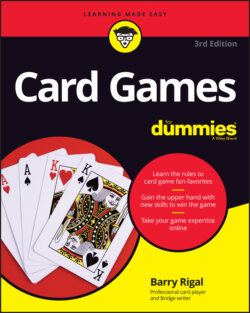Читать книгу Card Games For Dummies - Barry Rigal - Страница 18
Getting a square deal
ОглавлениеIn most games, one player is responsible for distributing the cards to the players — this player is the dealer. For the first hand, you often select the dealer by having each player draw a card from the deck; the lowest card (or, perhaps, the highest) gets to deal. After the first hand is complete, the rules of most games dictate that the player to the dealer’s left deals the next hand, with the deal rotating clockwise.
Before the deal for the first hand, a process may take place to determine where the players sit. In games in which your position at the table is important, such as Poker or Hearts, you often deal out a card to each player and then seat the players clockwise in order from highest to lowest.
The player to the dealer’s left, frequently the first person to play a card after the deal, is known as the elder or eldest hand. The younger hand is the player to the dealer’s right. These players may also be known as the left hand opponent and right hand opponent (which you sometimes see abbreviated as LHO and RHO). The dealer may also refer to the player sitting opposite them — their partner in a partnership game — as the CHO, or center hand opponent.
You may have been brought up on the sober concept that the right way to distribute the cards to each player is to pass them out one at a time, face-down, in a clockwise manner. However, that style is by no means the only possible, or indeed acceptable, way to deal. Games from south and eastern Europe and Switzerland, as well as tarot games, feature counterclockwise dealing and playing. And in Euchre the cards are dealt clockwise, but in batches of two or three, rather than one at a time.
The due process of a deal involves the dealer taking the deck in one hand and passing a single card from the top of the deck to the player on their left, in such a way that nobody can see the face of the card. The dealer then does the same for the next player, and so on around the table. The process continues until everyone receives their due number of cards.
Players generally consider it bad form for any player to look at their cards until the deal has been completed.
In several games, only some of the cards are dealt out. In such games, you put a parcel of undealt cards in a pile in the middle of the table. This pile is known as the stock or talon. Frequently, the dealer turns the top card of the stock face-up for one reason or another, and this card is known as the up-card.
The cards dealt out to a player, taken as a whole, constitute a hand. It’s normal practice to pick up your hand at the conclusion of the deal and to arrange the hand in an overlapping fan shape; if you like, you can sort the cards out by suit and rank, as appropriate for the game you’re playing, to make your decision making easier. Make sure, however, to take care that no one but you can see your cards. Similarly, you shouldn’t make any undue efforts to look at any one else’s hand.
Most card games need not only a dealer (a job that changes from hand to hand) but also a scorekeeper — not normally a sought-after task. The least innumerate mathematician may be landed with the task — or the soberest player. The good news is that scientific studies have shown that the scorer generally wins the game. I wonder why!
